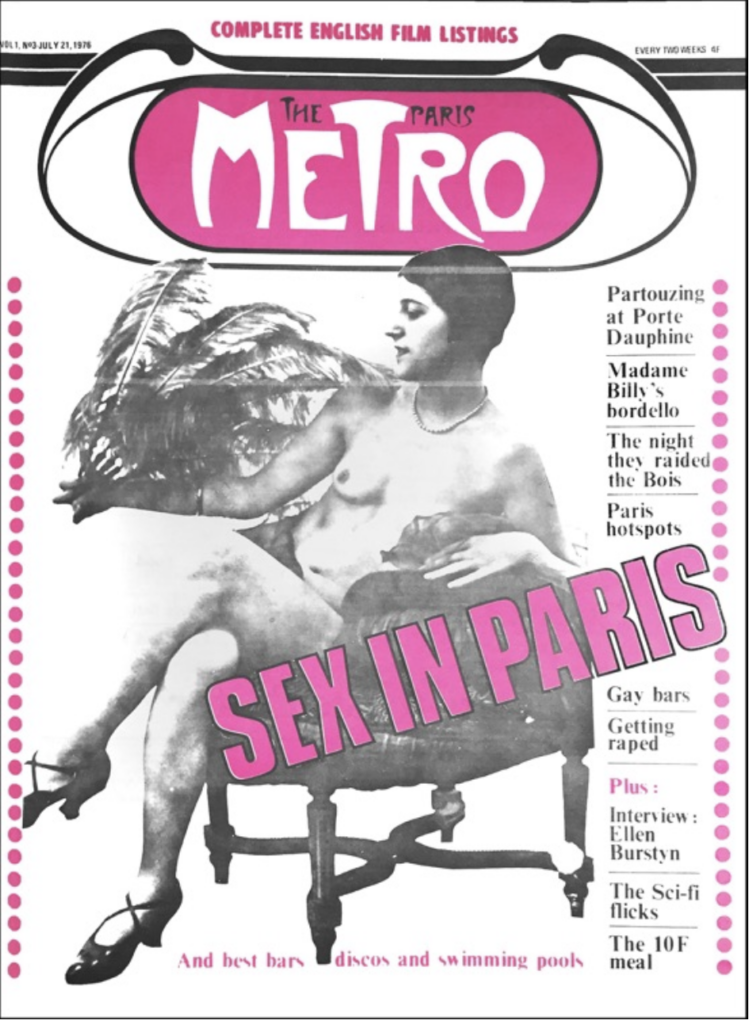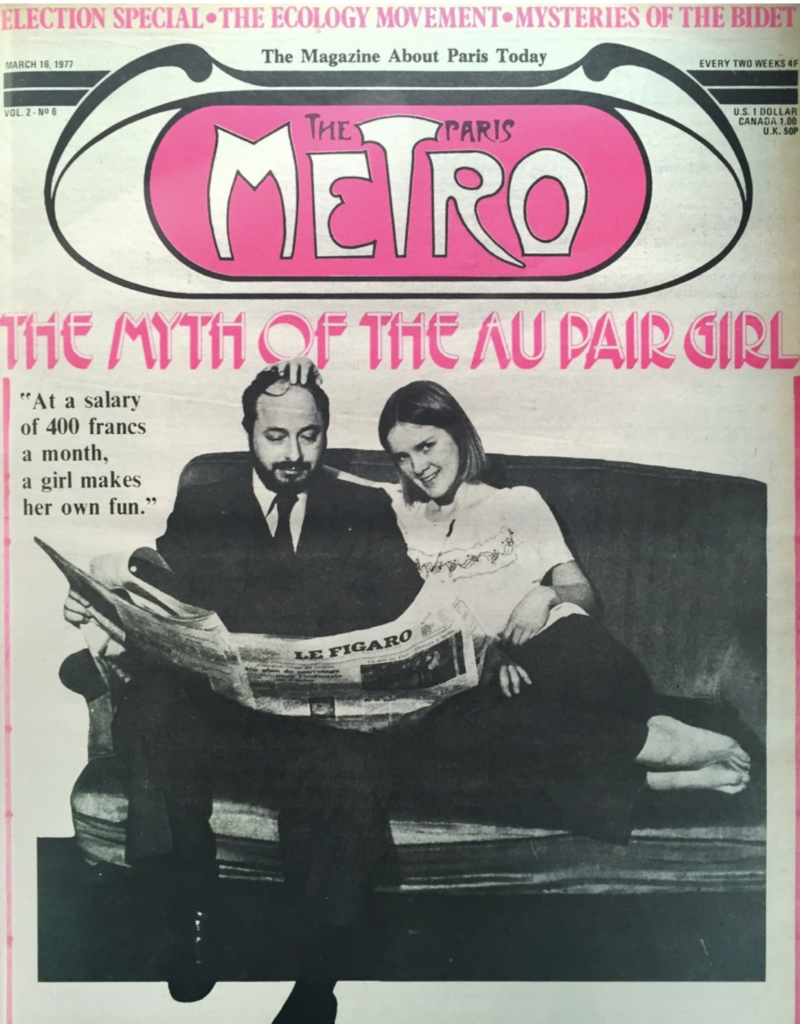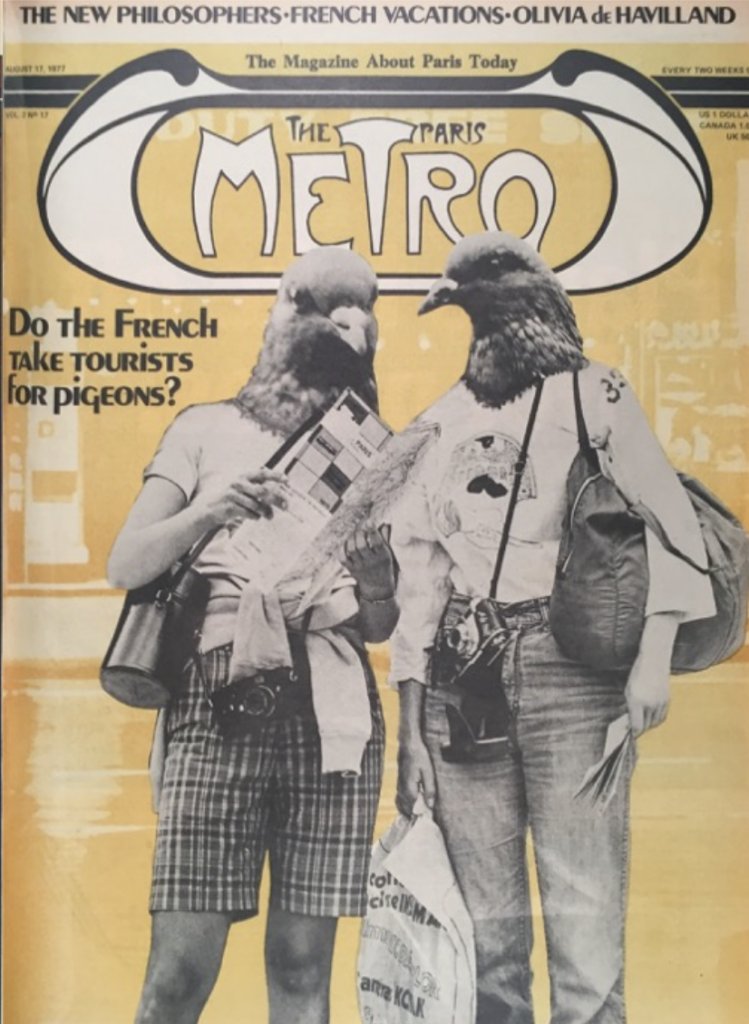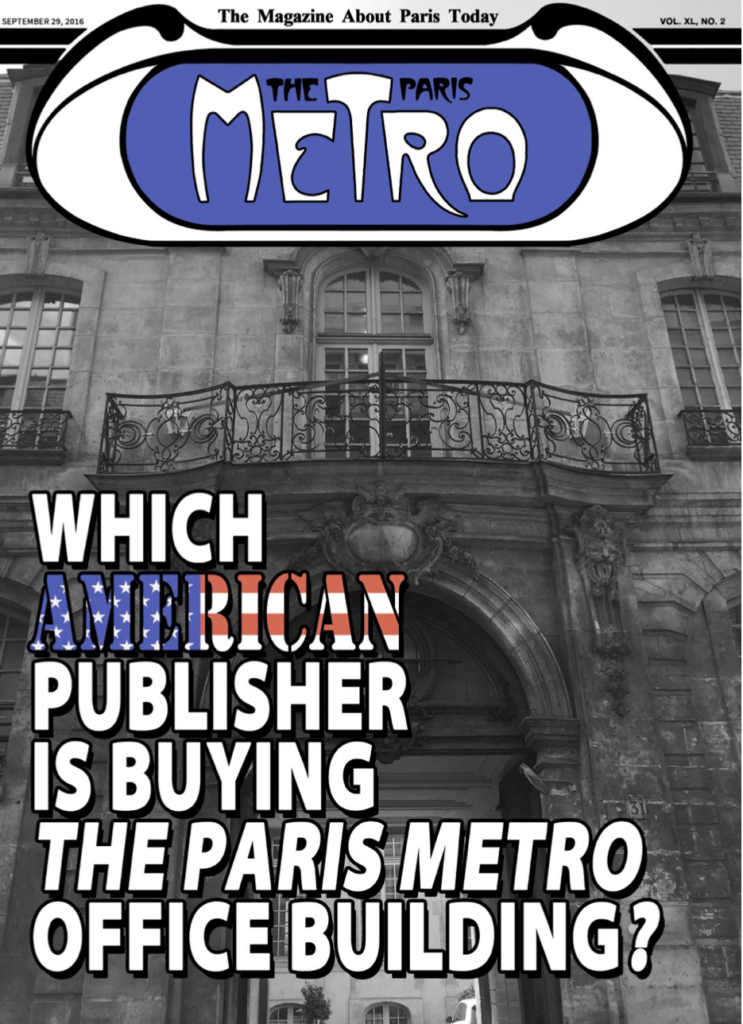The Life and Times of The Paris Metro

Cover of The Paris Metro. Courtesy of the fortieth anniversary issue, published in 2016.
In 1974, Harry Stein and Thomas Moore, young editors who’d worked together at New Times, a glossy biweekly in New York, had an idea: Let’s start a magazine—in Paris. Moore had recently come into a windfall when one of his articles, about a bank robbery in Brooklyn, became the basis for the film Dog Day Afternoon. He moved to Paris, following his then girlfriend; the relationship ended, but he stayed. Stein had previously lived in Paris, writing features for the International Herald Tribune, and also had a European girlfriend at the time. At first, the idea seemed impossible: Maybe we should sell baseball caps instead of starting a magazine, Stein thought. But Moore had a vision. He stole the name from the café outside his living room window, stole the masthead logo from the subway sign, and their publication was born: The Paris Metro.
Stein and Moore called Joel Stratte-McClure, a fellow journalist then in Paris on assignment, to tell him that they had a “scoop” on a nuclear meltdown and ask him to meet them in the Bar Hemingway at the Ritz. (There was no meltdown.) Several martinis in, Stratte-McClure joined the Metro team. He quickly became one of the core reporters, writing everything from regular features—an On the Money column, which advised readers about how to invest in wine or bet on horses—to cover stories like “Our Man in the Seine: Gets to the Bottom of the Dirty River—And Comes Back Alive!” A few months later, Moore approached Stratte-McClure about a new role. “Do you balance your checkbook?” Moore asked. “Of course. I’m a fanatic about it,” said Stratte-McClure. Moore’s follow-up: “Would you like to be publisher?”
Nothing else remotely like Metro existed at the time. Other English-language competitors like the Herald Tribune provided local news coverage, but the Metro offered a full high-low smorgasbord, from in-depth interviews with city employees to poetry by writers such as Gregory Corso and capsule reviews of Paris’s worst restaurants to coverage of pickup softball leagues. Stratte-McClure told me in a recent interview that the Metro routinely “tackled taboo subjects. Money, salary, who’s voting for whom, personal details about people.” The Metro also had a robust list of what was going on in Paris, such as job opportunities (“URGENT: Seek Modern Dance Teacher”), personal ads (“WIFE JUST DIED—looking for attractive woman dress size 36, between 20 & 31”; “I should like to offer my husband a totally original birthday present: a good meal out with an attractive girl/woman”), requests for information (“Have you had an abortion in Paris? Share your experience with your sisters”), events (such as, on Bastille Day, the Communist Party’s “traditional swinging affair on the Île Saint-Louis”), and shoestring-budget recipes (“In addition to being extremely good for your health, chicken livers are the biggest bargain at Monoprix”). The magazine allowed its writers the freedom to write what they wanted: to explore longer-form stories that leaned quirky, the result of enmeshment in a subculture or riffing on one’s pet topic.

Cover of The Paris Metro. Courtesy of the fortieth anniversary issue, 2016.
The Metro had its finger on the pulse of Parisian life—or, at least, the life that expats mythologized: one in which, upon arriving in the City of Lights, one immediately was in an intime inner circle with France’s most glamorous celebrities. In the magazine’s first issue, an interview with Jean Seberg, the star of Godard’s Breathless, spoke frankly about the difficulties of being a working actress in her thirties, no longer an ingenue yet unable to get cast in meaty character roles. A luxurious interview with Henry Miller, which ranged from discussions of sex to watercolors to American politics (“Take Ford, for example. My God, he’s worse than Nixon. He’s more stupid”), featured a full-page photo spread of the author playing ping-pong with a nude, blond model. Karl Lagerfeld posed for the “Disco Fever Paris” cover in the style of John Travolta. Another cover story, “Do the French Take Tourists for Pigeons?,” superimposed pigeon heads onto the most stereotypically American-looking people, strolling the Seine in crummy shorts and cameras. For a high-fashion issue, they posed a supermodel in Yves Saint-Laurent next to a clochard with a bottle of champagne and a cigar.
Intuition, serendipitous connections, and being in the right place at the right time helped the founders catapult their publication to the center of a Parisian zeitgeist. Though it would last for only two years, the Metro became a gravitational force field for American journalists in Paris. “Writers would appear off the street,” Stein told me. Young Metro contributors like Frank Rich, Roger Cohen, and Joan Dupont would go on to have international careers. The Metro itself would become a fashion accessory—people who didn’t even read English bought the magazine, to see and be seen with le magazine hot.
Most importantly, the editors and writers—and, it seemed, readers—were having fun. “The more we criticized the French, the more they loved us,” said Stein. The journalist Dominique Torrès, laid up in her apartment with a broken leg, wrote a column on “What’s In and What’s Out in Paris.” The column was blatantly arbitrary, yet many readers took it seriously, writing into the Metro that they’d pinned it to their kitchen walls. Stein and Stratte-McClure claimed, when I spoke with them, that Torrès’s column was the first of its kind, a precursor to hot-or-not indices like New York Magazine’s Approval Matrix. An early cover story featured an in-depth ranking of the best ice cream shops in Paris, with an illustration of a cartoon figure licking a giant cone in the shape of an upside-down Eiffel Tower that transforms, in the final panel, into a bottle of wine. The major scoop: Berthillon, long-acknowledged crème de les crème of Parisian glacé, was ranked only fourth, because the owners had been rude to the Metro’s reporter.
Especially in the early days, the Metro was never afraid to go there. (Stratte-McClure told me that one of his favorite cover stories was “Where to Go in Paris,” a review of Paris’s public toilets.) The July 1976 “Sex in Paris” issue reviewed the gay bars of Gay Paree with unabashed frankness. “Partouzing at the Porte Dauphine” taught readers the art of wife-swapping and orgy orchestration at a major traffic intersection, which was a famous central hub for swingers. “I stop the car under a street lamp, figuring the other couples will see us better. I feel like a storefront,” Richard Goodman, intrepid reporter, wrote, describing a trip undertaken along with his wife, Helen. “The flesh agent, leaving us no time to decide, is already forming the group—five cars, six couples and himself—into a wagon train. On his signal, which sounds eerily like ‘Roll ’em out,’ we pull out toward his place.” Leaving nothing to the imagination, Goodman takes the reader straight from the partouze to the voulez-vous to the rendezvous. “After a good half-hour of rising and falling,” he wrote of his wife swap, “I fall back triumphantly, proud of my performance but still insincere enough to ask, ‘How was it for you?’ She rolls her eyes in response. I love it.”
For “The Doorman Bigger Than the Ritz,” an exposé on behind-the-scenes hotel life, Stratte-McClure interviewed a disillusioned teenager working as a bellhop at the Ritz—identified in his photo caption as simply “Henri, 18, Communist”—who reported very frankly on his experiences. “The Ritz is not the same for its employees as it is for guests,” he said. Not only did employees earn less in a month than top clients spent in a single night, “the basement [had] the smell of dead rats and the breakfasts they feed us are terrible.” But Stratte-McClure didn’t think through the ramifications—though the Ritz wasn’t an advertiser itself, others might not be so comfortable signing over their dollars to a newspaper liable to blast them in its pages.

Cover of The Paris Metro. Courtesy of the fortieth anniversary issue, 2016.
All of this came at a price. After “Sex in Paris,” Stratte-McClure told me that several potential advertisers simply stopped replying to their calls. Despite the boon of some major companies like Air France and Philip Morris advertising in its pages, the Metro was always bleeding money. Instead of retaining a strict low page count and therefore a limited printing budget, the magazine ballooned in size, sprawling to fifty color pages. As Stein told me, “French media outfits, and banks started throwing money at us—alas, money that eventually had to be repaid. Had we retrenched, stayed at the initial twenty-four pages as circulation and advertising continued to build, we would have had a chance. But none of us understood that. Like most of us, I got my family to invest in the Metro, truly believing, idiot that I was, that it was destined to be a mammoth success.” Even in the magazine’s last weeks, the editors were searching for a larger office to accommodate future daycare for pregnant staff writers.
In 1978, Stratte-McClure told me, the Metro put together a handshake deal with the Herald Tribune to become that publication’s Sunday supplement section. At the last moment, however, the Tribune pulled out. In retrospect, “the reason it didn’t work was pretty obvious,” Stratte-McClure told me. “We had half a million dollars in debt. No one in their right mind would incur half a million dollars in debt.” Once that deal fell apart, it was lights out for the Metro.

Cover of The Paris Metro. Courtesy of the fortieth anniversary issue, 2016.
The Metro was short-lived, but its legend has a long afterlife. A 2016 fortieth-anniversary-edition collection about the magazine features a nostalgia-larded parade of essays dedicated to chronicling those brief yet momentous two years, and there’s a television show in development about the glory days. And yet, or, arguably, relatedly, the magazine is not digitized—if you want to look at all the back issues, you still have to actually go to Paris to read the Metro. Even this captures an element of expatriate Parisian life many writers wish we could return to. Back then, Stein recalled, Paris truly was a world away. “You were really gone,” Stein told me. “Cut off from the States, didn’t make phone calls to people, no internet. Turkish toilets in every café. Everyone smoked Gitanes or Gauloises. Our whole sense of life was inhaling that noxious smoke.” Of course, this too is myth. As a friend of the Metro put it, “It’s hard not to feel like the rest of life couldn’t have been as fun as that.”
Adrienne Raphel is the author of Thinking Inside the Box: Adventures with Crosswords and the Puzzling People who Can’t Live Without Them, Our Dark Academia, and What Was It For.
Copyright
© The Paris Review
